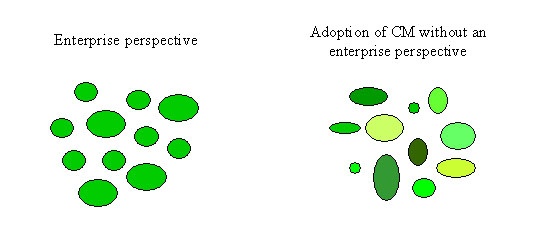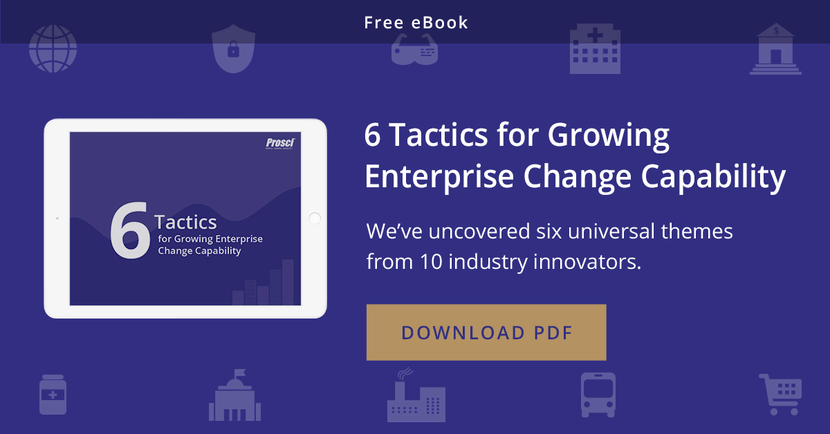Making the Case for a Common Approach to Managing Change

5 Mins
Updated: June 24, 2022
Published: June 24, 2015

Why use a common approach to managing change?
Ten years ago, Prosci began research and development to address the question: How do I deploy change management throughout my organization? The result is what Prosci is calling Enterprise Change Management.
This tutorial presents a case for using a common approach to manage change - including the benefits of a common approach and the risks of ad hoc approaches.
Making the case for a common approach to managing change
The case for adopting an enterprise perspective related to change management is one that must be made to the senior leadership and those involved with the deployment decision, funding and design. There may be others in the organization that you will need to make the ‘why enterprise change management’ case to, including people already using their own approach to change management, members of the project management office, members of other staff functions (HR, communication, training, etc.).

Who are the players?
- People already using their own approach to change management
These individuals are the change experts already in your organization. The prospect of a common approach to change management may threaten the comfort and experience they have with their own change management approach. You can anticipate resistance from this group, and will need to involve sponsors to build an awareness of the need for adopting a common approach.
- Members of the project management office
Some organizations already experience resistance the change management from project members. The most common sources of resistance are "I'm already doing this" (when in fact they are not) or "This isn't my job" (because change management does take time and resources, and many project members don't feel they have the resources).
- Members of other staff functions (HR, OD, communication, training, etc.)
These groups will be required to support the deployment and adoption of change management throughout the organization. For them, a common change management approach can provide context about how they support successful change in your organization.
- Senior leaders necessary to sponsor the building of change management competencies
There will be a number of senior leaders that need to be on board - including the primary sponsor who authorizes and funds the change competency program and other leaders who must actively and visibly support the program with their organizations and direct reports.
Why use a common approach?
Advantages of a common approach
The key advantages for deploying ECM and using a common approach are similar to the benefits of any standardization that might occur in your organization. For change management, some of the central advantages include:
- Common language
There is a tremendous advantage to having all the people in your organization who deal with change using the same terms and phrases when discussing change management. This prevents confusion and allows discussions to move more quickly to the real issues rather than getting caught up in definitions.
- Shorter learning curve
Throughout the organization, individuals will be able to more quickly learn and apply a common approach, as they will be exposed to similar and repeated elements.
- More consistent application
A common approach provides more consistent application of effective change management across multiple projects, initiatives, divisions and regions. Common processes, tools and activities will be shared.
- Common and shared resources
Applying multiple approaches in the organization requires more resources than applying a common approach. Practitioners can utilize common sets of tools. Also, a single support person (such as a change management specialist or human resource consultant) can more easily support multiple change projects in different parts of the business.
- Greater opportunity for continuous improvement
One of the main advantages of a common approach with ECM is that there are more opportunities to continuously improve your change management techniques, process and tools. With different project teams and groups applying a common approach, you can find out what is working, and what is not working, and make adjustments to the approach. With multiple different approaches, there is little room to refine processes since there is not a common base from which to begin making adjustments. ECM allows teams to leverage the lessons learned and best practices from other teams as they work to manage change on their own project.
- Prevention of 'reinventing the wheel'
Why solve problems again that have already been solved in your organization? A common approach to managing change is more efficient, as the tedious and resource intensive task of defining what to do is eliminated.
What are the risks of different approaches?
In addition to the benefits of a common approach, there are potential risks of allowing project teams throughout the organization to use different approaches to change management.
The major risk of having multiple approaches in the organization is that there are certain people (or roles) that will be exposed to these different approaches at the same time - a collision of multiple approaches. One particular change management team may not mind that others in the organization are using different approaches, but for an individual that gets bombarded by several approaches, this can be confusing and even aggravating. The following groups run the risk of facing a collision of multiple approaches:
- Executives and senior leaders (acting as change management sponsors)
- Managers and supervisors (acting as coaches of change)
- HR, training, communication staff (supporting the human development side of change management)
- Project team members working on multiple projects or on one project after another
Example of sponsor collision:
Imagine that you are a senior leader who has authority over five different projects impacting the organization. Each of the five project teams is using change management. This is a good thing, right? However, each time a different group comes to you they are giving you different roles and responsibilities. They are using different words to talk about the same thing. They even get frustrated when you try to ask them a question using one of the other group's terms. How do you respond?
Example of coach collision
Imagine that you are a mid-level manager. The organization has said that they want you to work with your direct reports on how to successfully navigate change. Great, you say. Your direct employees have two main initiatives that will be impacting their day-to-day work - a new performance measurement system and a new set of online tools to support client interactions. Both project teams schedule a half-day training for you on change management. Both sessions were good, but they had nothing in common! They both used different terminology, and suggested different activities. Upon reflection, you are confused about what needs to be done with your people. While you see the merit in both, you have a group of 12 direct reports and you need to do something with them. How do you respond?
When these groups experience multiple approaches, a common response is to disengage and not fulfill any of the conflicting roles that different groups are presenting to them. Disengagement results in each of the change management efforts coming up short, and can actually result in less effectively managed change.
A final note on making the case for ‘why’
It is important to make the ‘why change management’ case specific to your audience. In your organization, this can include using phrases that your people feel comfortable with or using examples that are part of the organization’s collective memory to demonstrate the impacts of poorly and effectively managed change. For specific audiences within your organization, this means tying change management to what they care about, what they worry about, and how applying change management will help them succeed at their job. From an enterprise perspective, this also means showing how a common approach will support the strategic direction and build competitive advantage in the organization.
ECM in your organization
ECM will look different in your organization than it does in other organizations. This is because the right deployment approach and ultimate future state will depend on your organization, its culture and how changes are initiated and implemented. All of these factors impact what the right ECM mix is for your organization and how you can most effectively get there.


